Improving students’ vocabulary using the diglot - Weave technique
This study investigated the effectiveness of the Diglot-Weave Technique
in helping non-English majors at Thai Nguyen University of Education
improve their vocabulary. The research aimed at investigating the current
situation of the students’ vocabulary, and the extent to which the DiglotWeave
Technique improved the students’ vocabulary. There were
participants who were non-English majors from 5 departments (Primary
Education, Biology, Mathematics, Physics, and Philology) at Thai
Nguyen University of Education. Two data collection instruments were
used, namely questionnaires, and tests. Before the study, most of the
students did not have adequate vocabulary and they had some difficulties
in learning vocabulary. The findings revealed the effectiveness of the
Diglot-Weave Technique in enhancing the students’ vocabulary. The
experimental group’s scores in the post-test were higher than those of the
control group and there was a difference between the pre-test and the
post-test scores of the experimental group. The majority of the students
thought the Diglot-Weave Technique was useful for them to guess the
meanings easier and remember words longer.
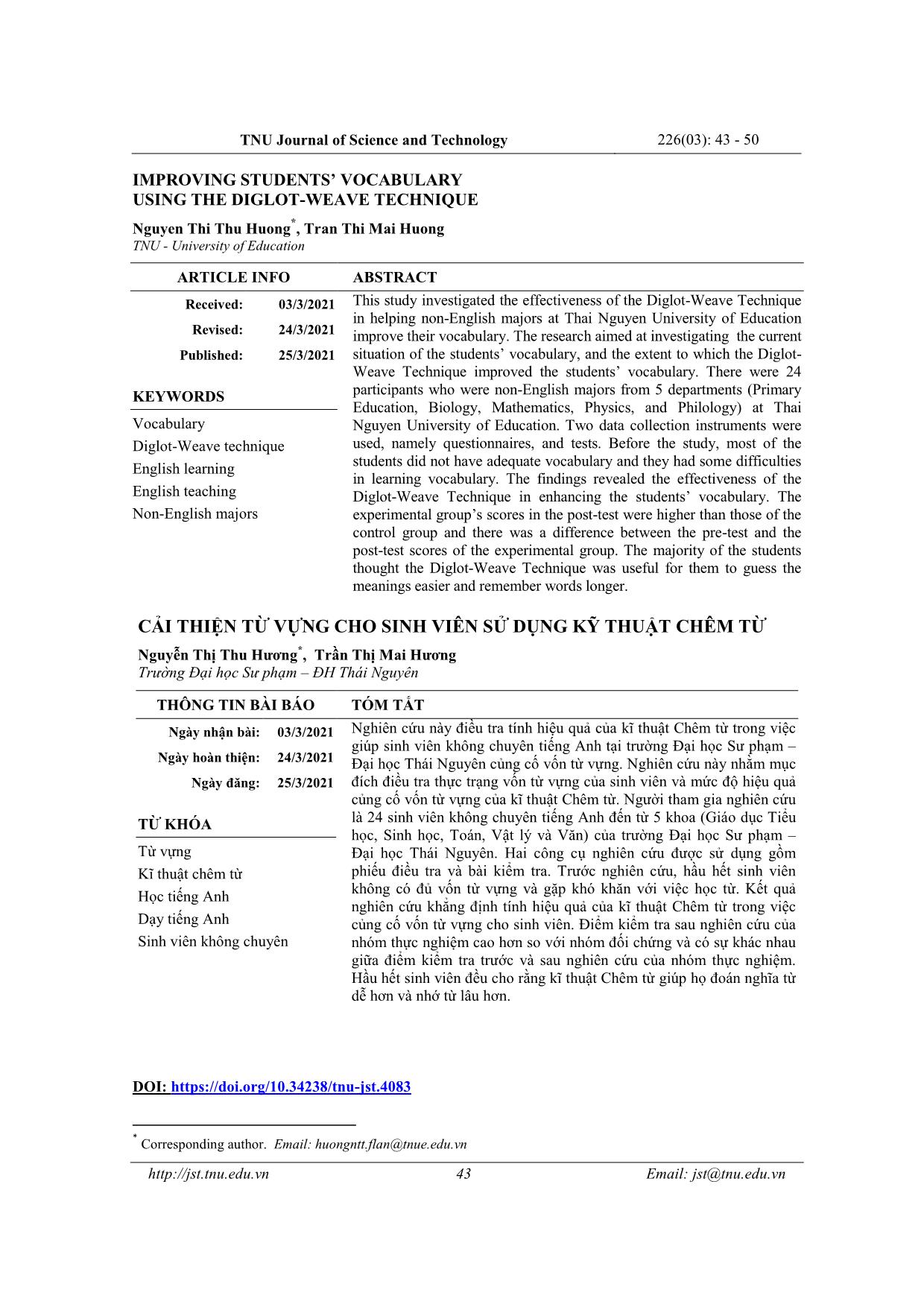
Trang 1
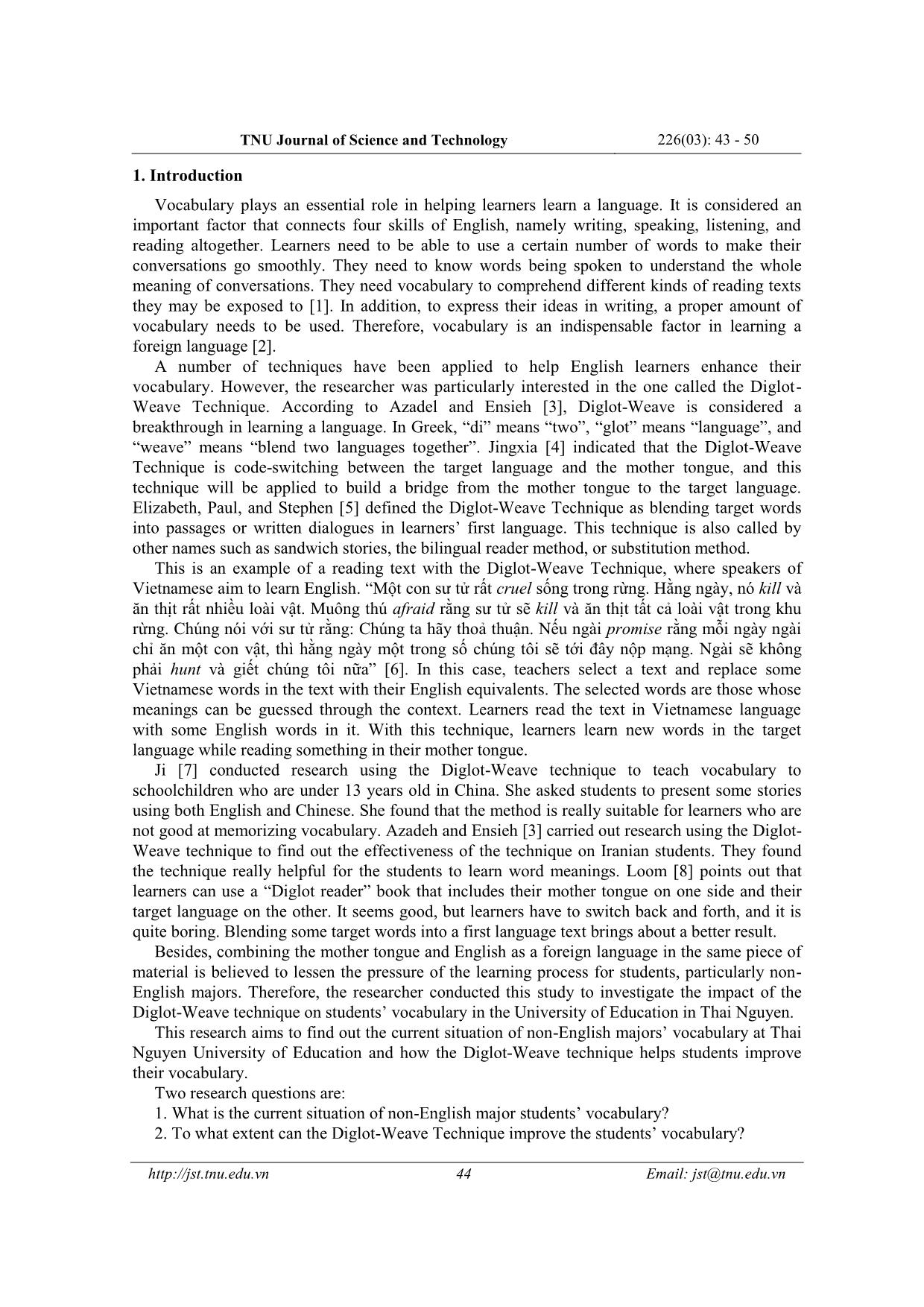
Trang 2
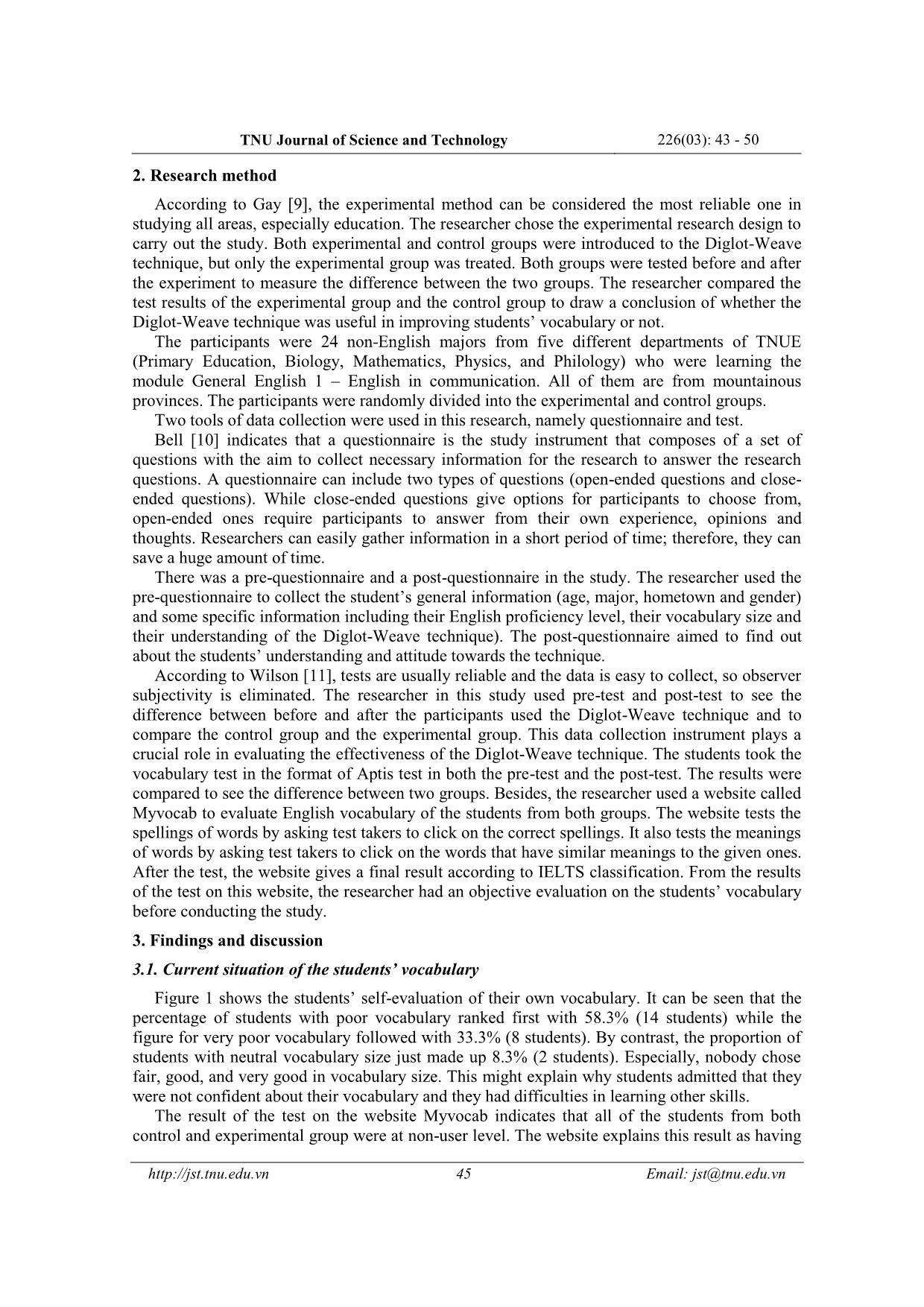
Trang 3
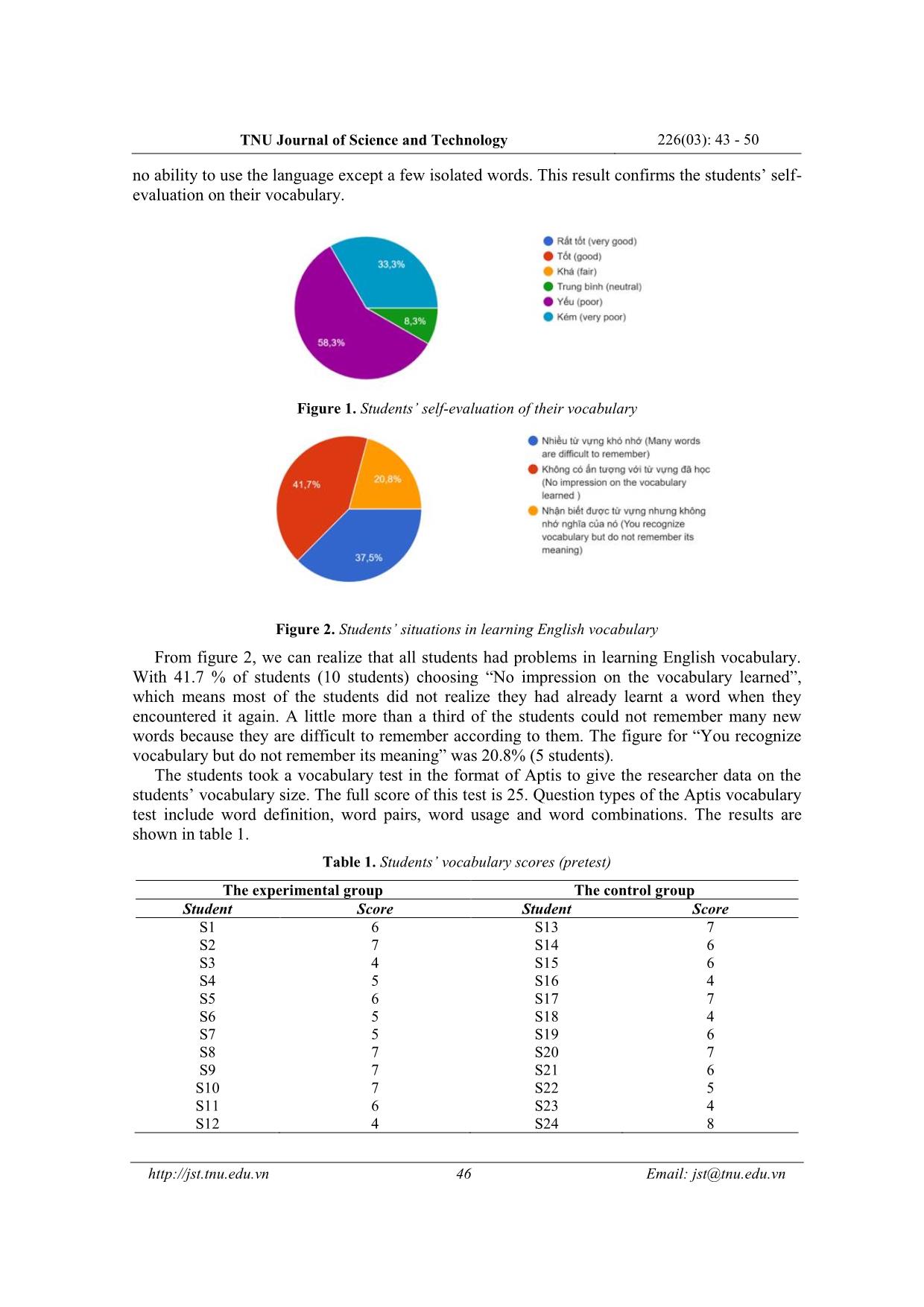
Trang 4
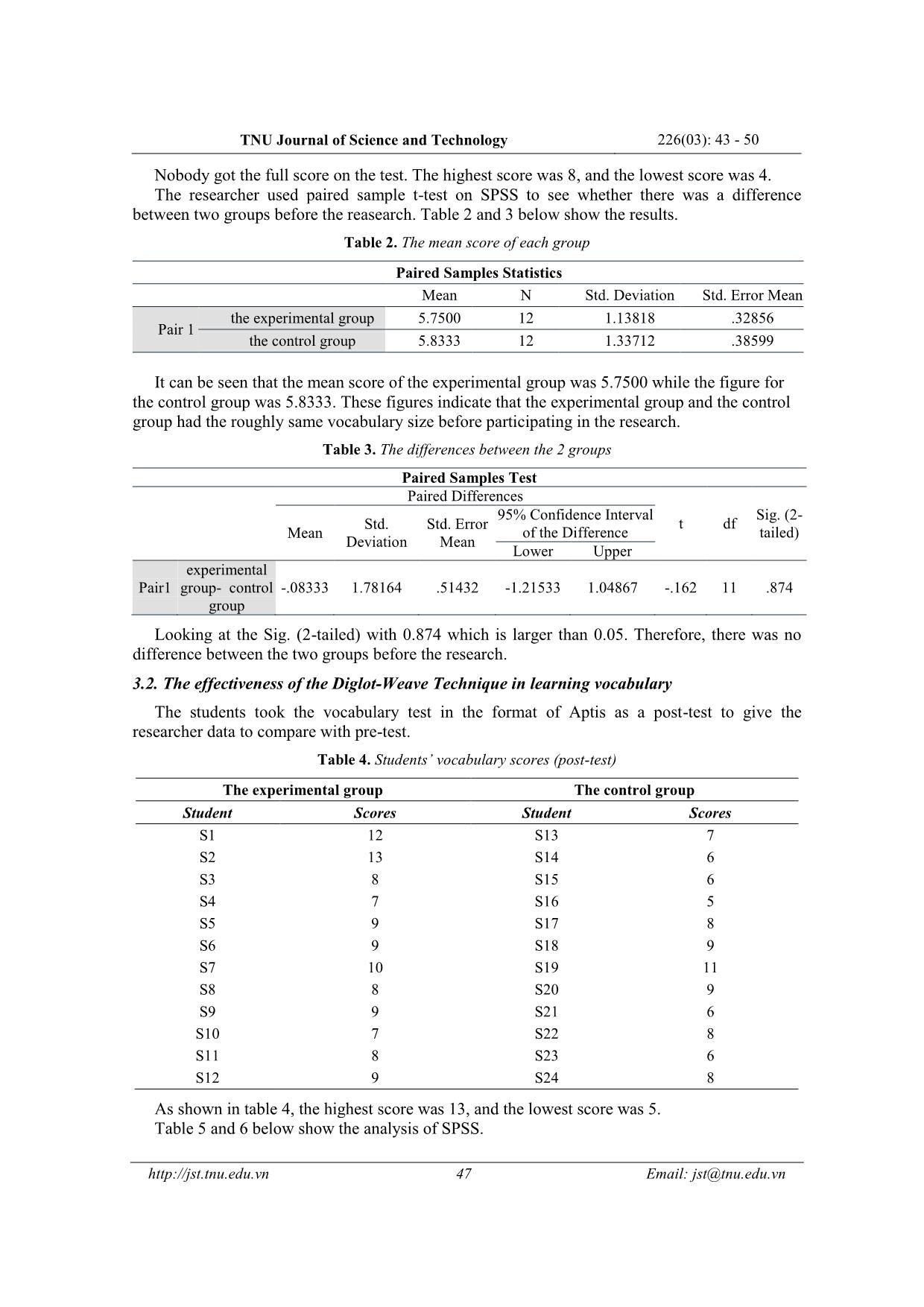
Trang 5
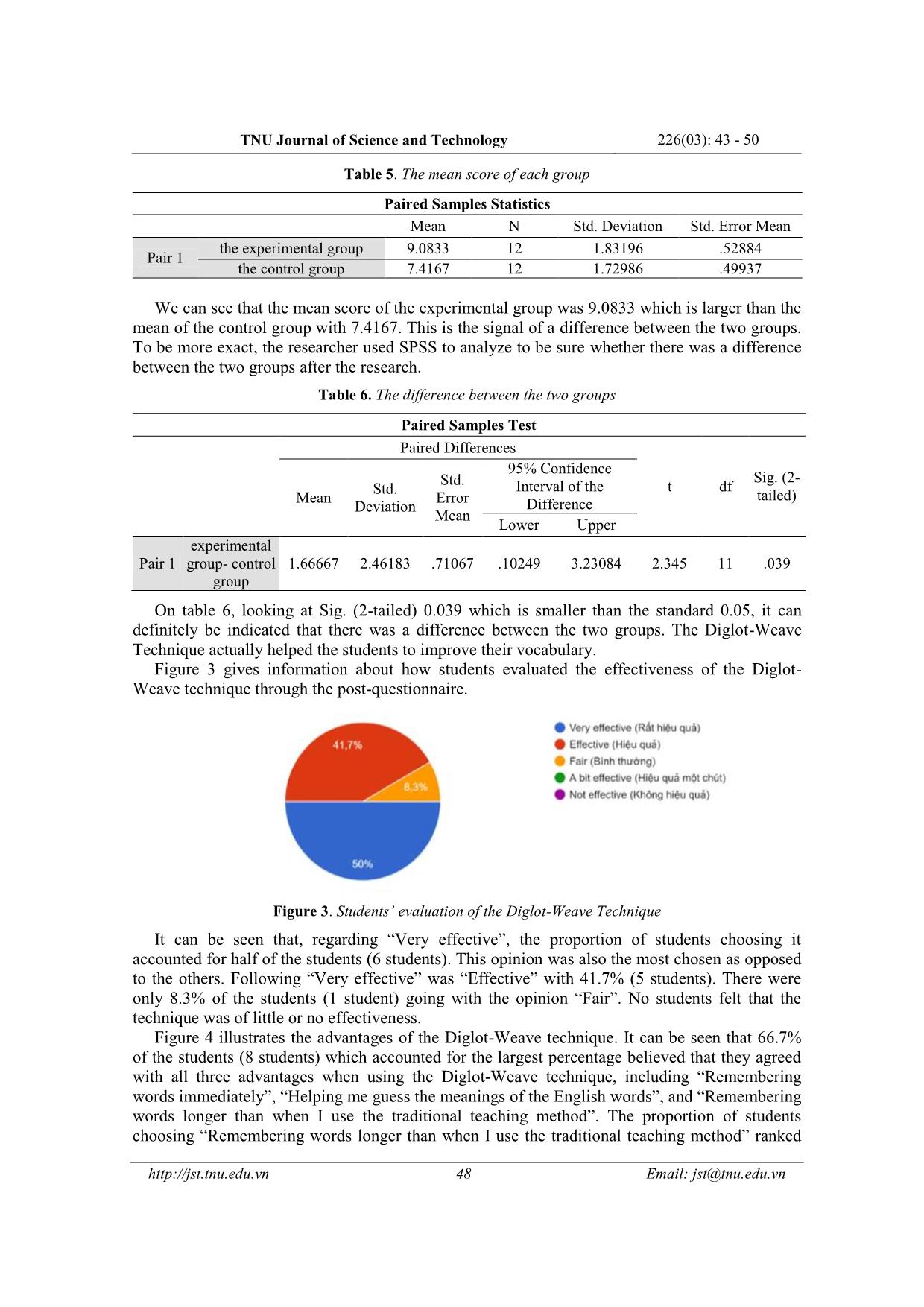
Trang 6
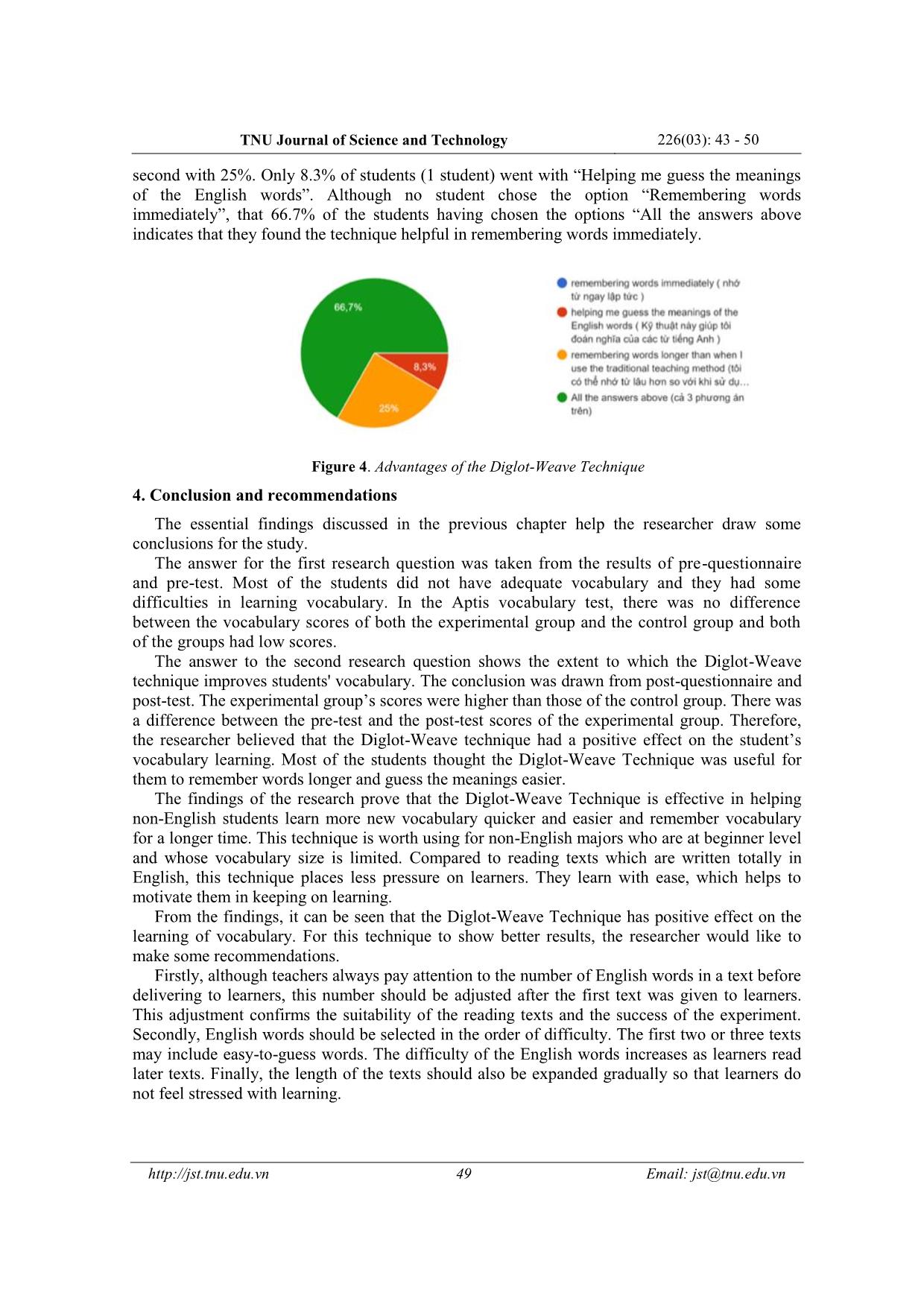
Trang 7
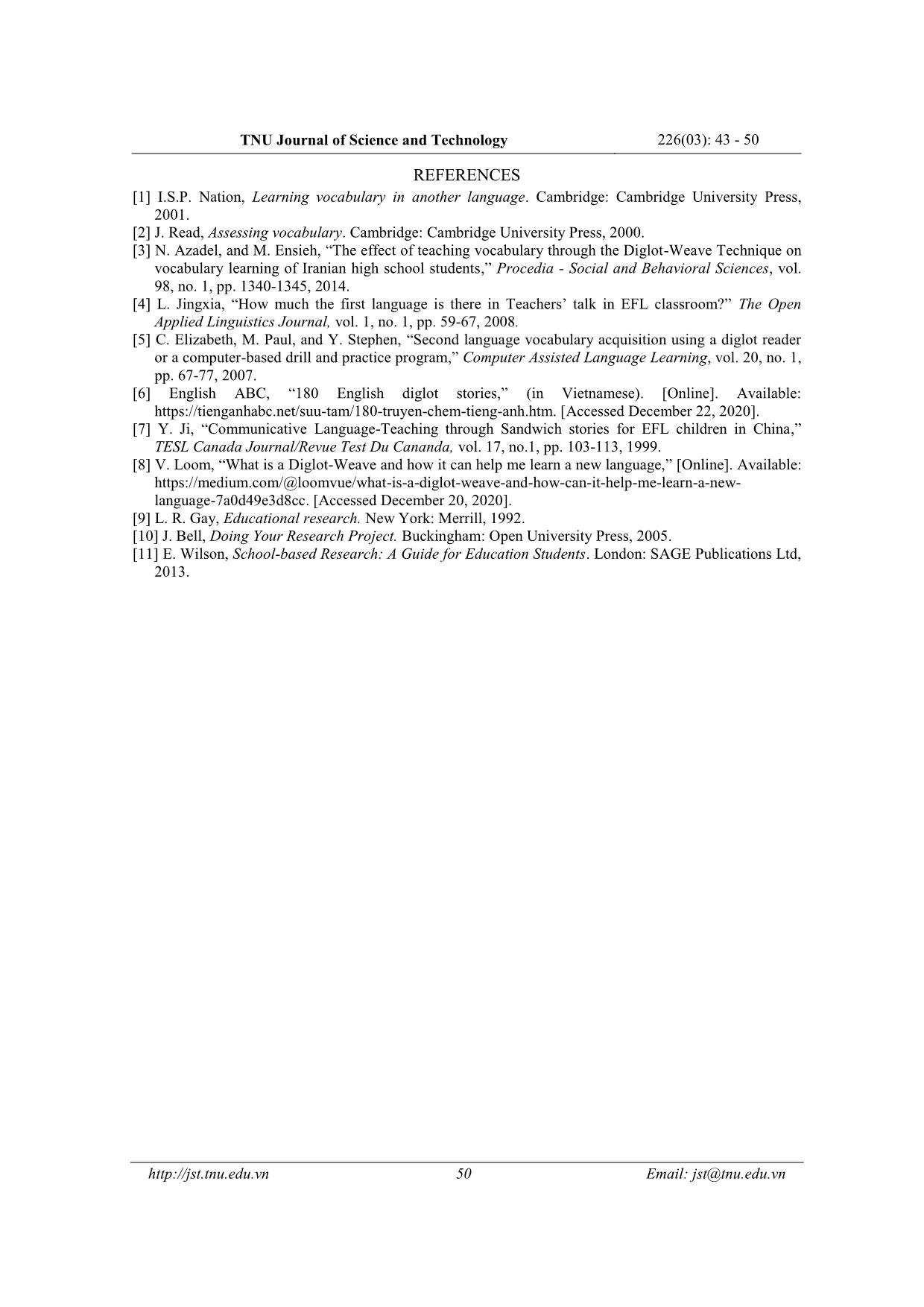
Trang 8
Tóm tắt nội dung tài liệu: Improving students’ vocabulary using the diglot - Weave technique

TNU Journal of Science and Technology 226(03): 43 - 50 43 Email: jst@tnu.edu.vn IMPROVING STUDENTS’ VOCABULARY USING THE DIGLOT-WEAVE TECHNIQUE Nguyen Thi Thu Huong * , Tran Thi Mai Huong TNU - University of Education ARTICLE INFO ABSTRACT Received: 03/3/2021 This study investigated the effectiveness of the Diglot-Weave Technique in helping non-English majors at Thai Nguyen University of Education improve their vocabulary. The research aimed at investigating the current situation of the students’ vocabulary, and the extent to which the Diglot- Weave Technique improved the students’ vocabulary. There were 24 participants who were non-English majors from 5 departments (Primary Education, Biology, Mathematics, Physics, and Philology) at Thai Nguyen University of Education. Two data collection instruments were used, namely questionnaires, and tests. Before the study, most of the students did not have adequate vocabulary and they had some difficulties in learning vocabulary. The findings revealed the effectiveness of the Diglot-Weave Technique in enhancing the students’ vocabulary. The experimental group’s scores in the post-test were higher than those of the control group and there was a difference between the pre-test and the post-test scores of the experimental group. The majority of the students thought the Diglot-Weave Technique was useful for them to guess the meanings easier and remember words longer. Revised: 24/3/2021 Published: 25/3/2021 KEYWORDS Vocabulary Diglot-Weave technique English learning English teaching Non-English majors CẢI THIỆN TỪ VỰNG CHO SINH VIÊN SỬ DỤNG KỸ THUẬT CHÊM TỪ Nguyễn Thị Thu Hương*, Trần Thị Mai Hương Trường Đại học Sư phạm – ĐH Thái Nguyên THÔNG TIN BÀI BÁO TÓM TẮT Ngày nhận bài: 03/3/2021 Nghiên cứu này điều tra tính hiệu quả của kĩ thuật Chêm từ trong việc giúp sinh viên không chuyên tiếng Anh tại trường Đại học Sư phạm – Đại học Thái Nguyên củng cố vốn từ vựng. Nghiên cứu này nhằm mục đích điều tra thực trạng vốn từ vựng của sinh viên và mức độ hiệu quả củng cố vốn từ vựng của kĩ thuật Chêm từ. Người tham gia nghiên cứu là 24 sinh viên không chuyên tiếng Anh đến từ 5 khoa (Giáo dục Tiểu học, Sinh học, Toán, Vật lý và Văn) của trường Đại học Sư phạm – Đại học Thái Nguyên. Hai công cụ nghiên cứu được sử dụng gồm phiếu điều tra và bài kiểm tra. Trước nghiên cứu, hầu hết sinh viên không có đủ vốn từ vựng và gặp khó khăn với việc học từ. Kết quả nghiên cứu khẳng định tính hiệu quả của kĩ thuật Chêm từ trong việc củng cố vốn từ vựng cho sinh viên. Điểm kiểm tra sau nghiên cứu của nhóm thực nghiệm cao hơn so với nhóm đối chứng và có sự khác nhau giữa điểm kiểm tra trước và sau nghiên cứu của nhóm thực nghiệm. Hầu hết sinh viên đều cho rằng kĩ thuật Chêm từ giúp họ đoán nghĩa từ dễ hơn và nhớ từ lâu hơn. Ngày hoàn thiện: 24/3/2021 Ngày đăng: 25/3/2021 TỪ KHÓA Từ vựng Kĩ thuật chêm từ Học tiếng Anh Dạy tiếng Anh Sinh viên không chuyên DOI: https://doi.org/10.34238/tnu-jst.4083 * Corresponding author. Email: huongntt.flan@tnue.edu.vn TNU Journal of Science and Technology 226(03): 43 - 50 44 Email: jst@tnu.edu.vn 1. Introduction Vocabulary plays an essential role in helping learners learn a language. It is considered an important factor that connects four skills of English, namely writing, speaking, listening, and reading altogether. Learners need to be able to use a certain number of words to make their conversations go smoothly. They need to know words being spoken to understand the whole meaning of conversations. They need vocabulary to comprehend different kinds of reading texts they may be exposed to [1]. In addition, to express their ideas in writing, a proper amount of vocabulary needs to be used. Therefore, vocabulary is an indispensable factor in learning a foreign language [2]. A number of techniques have been applied to help English learners enhance their vocabulary. However, the researcher was particularly interested in the one called the Diglot- Weave Technique. According to Azadel and Ensieh [3], Diglot-Weave is considered a breakthrough in learning a language. In Greek, “di” means “two”, “glot” means “language”, and “weave” means “blend two languages together”. Jingxia [4] indicated that the Diglot-Weave Technique is code-switching between the target language and the mother tongue, and this technique will be applied to build a bridge from the mother tongue to the target language. Elizabeth, Paul, and Stephen [5] defined the Diglot-Weave Technique as blending target words into passages or written dialogues in learners’ first language. This technique is also called by other names such as sandwich stories, the bilingual reader method, or substitution method. This is an example of a reading text with the Diglot-Weave Technique, where speakers of Vietnamese aim to learn English. “Một con sư tử rất cruel sống trong rừng. Hằng ngày, nó kill và ăn thịt rất nhiều loài vật. Muông thú afraid rằng sư tử sẽ kill và ăn thịt tất cả loài vật trong khu rừng. Chúng nói với sư tử rằng: Chúng ta hãy thoả thuận. Nếu ngài promise rằng mỗi ngày ngài chỉ ăn một con vật, thì hằng ngày một trong số chúng tôi sẽ tới đây nộp mạng. Ngài sẽ không phải hunt và giết chúng tôi nữa” [6]. In this case, teachers select a text and replace some Vietnamese words in the text with their English equivalents. The selected words are those whose meanings can be guessed through the context. Learners read the text in Vietnamese language with some English words in it. With this technique, learners learn new words in the target language while reading something in their mother tongue. Ji [7] conducted research using the Diglot-Weave technique to teach vocabulary to schoolchildren who are under 13 years old in China. She asked students to present some stories using both English and Chinese. She found that t ... were randomly divided into the experimental and control groups. Two tools of data collection were used in this research, namely questionnaire and test. Bell [10] indicates that a questionnaire is the study instrument that composes of a set of questions with the aim to collect necessary information for the research to answer the research questions. A questionnaire can include two types of questions (open-ended questions and close- ended questions). While close-ended questions give options for participants to choose from, open-ended ones require participants to answer from their own experience, opinions and thoughts. Researchers can easily gather information in a short period of time; therefore, they can save a huge amount of time. There was a pre-questionnaire and a post-questionnaire in the study. The researcher used the pre-questionnaire to collect the student’s general information (age, major, hometown and gender) and some specific information including their English proficiency level, their vocabulary size and their understanding of the Diglot-Weave technique). The post-questionnaire aimed to find out about the students’ understanding and attitude towards the technique. According to Wilson [11], tests are usually reliable and the data is easy to collect, so observer subjectivity is eliminated. The researcher in this study used pre-test and post-test to see the difference between before and after the participants used the Diglot-Weave technique and to compare the control group and the experimental group. This data collection instrument plays a crucial role in evaluating the effectiveness of the Diglot-Weave technique. The students took the vocabulary test in the format of Aptis test in both the pre-test and the post-test. The results were compared to see the difference between two groups. Besides, the researcher used a website called Myvocab to evaluate English vocabulary of the students from both groups. The website tests the spellings of words by asking test takers to click on the correct spellings. It also tests the meanings of words by asking test takers to click on the words that have similar meanings to the given ones. After the test, the website gives a final result according to IELTS classification. From the results of the test on this website, the researcher had an objective evaluation on the students’ vocabulary before conducting the study. 3. Findings and discussion 3.1. Current situation of the students’ vocabulary Figure 1 shows the students’ self-evaluation of their own vocabulary. It can be seen that the percentage of students with poor vocabulary ranked first with 58.3% (14 students) while the figure for very poor vocabulary followed with 33.3% (8 students). By contrast, the proportion of students with neutral vocabulary size just made up 8.3% (2 students). Especially, nobody chose fair, good, and very good in vocabulary size. This might explain why students admitted that they were not confident about their vocabulary and they had difficulties in learning other skills. The result of the test on the website Myvocab indicates that all of the students from both control and experimental group were at non-user level. The website explains this result as having TNU Journal of Science and Technology 226(03): 43 - 50 46 Email: jst@tnu.edu.vn no ability to use the language except a few isolated words. This result confirms the students’ self- evaluation on their vocabulary. Figure 1. Students’ self-evaluation of their vocabulary Figure 2. Students’ situations in learning English vocabulary From figure 2, we can realize that all students had problems in learning English vocabulary. With 41.7 % of students (10 students) choosing “No impression on the vocabulary learned”, which means most of the students did not realize they had already learnt a word when they encountered it again. A little more than a third of the students could not remember many new words because they are difficult to remember according to them. The figure for “You recognize vocabulary but do not remember its meaning” was 20.8% (5 students). The students took a vocabulary test in the format of Aptis to give the researcher data on the students’ vocabulary size. The full score of this test is 25. Question types of the Aptis vocabulary test include word definition, word pairs, word usage and word combinations. The results are shown in table 1. Table 1. Students’ vocabulary scores (pretest) The experimental group The control group Student Score Student Score S1 6 S13 7 S2 7 S14 6 S3 4 S15 6 S4 5 S16 4 S5 6 S17 7 S6 5 S18 4 S7 5 S19 6 S8 7 S20 7 S9 7 S21 6 S10 7 S22 5 S11 6 S23 4 S12 4 S24 8 TNU Journal of Science and Technology 226(03): 43 - 50 47 Email: jst@tnu.edu.vn Nobody got the full score on the test. The highest score was 8, and the lowest score was 4. The researcher used paired sample t-test on SPSS to see whether there was a difference between two groups before the reasearch. Table 2 and 3 below show the results. Table 2. The mean score of each group Paired Samples Statistics Mean N Std. Deviation Std. Error Mean Pair 1 the experimental group 5.7500 12 1.13818 .32856 the control group 5.8333 12 1.33712 .38599 It can be seen that the mean score of the experimental group was 5.7500 while the figure for the control group was 5.8333. These figures indicate that the experimental group and the control group had the roughly same vocabulary size before participating in the research. Table 3. The differences between the 2 groups Paired Samples Test Paired Differences t df Sig. (2- tailed) Mean Std. Deviation Std. Error Mean 95% Confidence Interval of the Difference Lower Upper Pair1 experimental group- control group -.08333 1.78164 .51432 -1.21533 1.04867 -.162 11 .874 Looking at the Sig. (2-tailed) with 0.874 which is larger than 0.05. Therefore, there was no difference between the two groups before the research. 3.2. The effectiveness of the Diglot-Weave Technique in learning vocabulary The students took the vocabulary test in the format of Aptis as a post-test to give the researcher data to compare with pre-test. Table 4. Students’ vocabulary scores (post-test) The experimental group The control group Student Scores Student Scores S1 12 S13 7 S2 13 S14 6 S3 8 S15 6 S4 7 S16 5 S5 9 S17 8 S6 9 S18 9 S7 10 S19 11 S8 8 S20 9 S9 9 S21 6 S10 7 S22 8 S11 8 S23 6 S12 9 S24 8 As shown in table 4, the highest score was 13, and the lowest score was 5. Table 5 and 6 below show the analysis of SPSS. TNU Journal of Science and Technology 226(03): 43 - 50 48 Email: jst@tnu.edu.vn Table 5. The mean score of each group Paired Samples Statistics Mean N Std. Deviation Std. Error Mean Pair 1 the experimental group 9.0833 12 1.83196 .52884 the control group 7.4167 12 1.72986 .49937 We can see that the mean score of the experimental group was 9.0833 which is larger than the mean of the control group with 7.4167. This is the signal of a difference between the two groups. To be more exact, the researcher used SPSS to analyze to be sure whether there was a difference between the two groups after the research. Table 6. The difference between the two groups Paired Samples Test Paired Differences t df Sig. (2- tailed) Mean Std. Deviation Std. Error Mean 95% Confidence Interval of the Difference Lower Upper Pair 1 experimental group- control group 1.66667 2.46183 .71067 .10249 3.23084 2.345 11 .039 On table 6, looking at Sig. (2-tailed) 0.039 which is smaller than the standard 0.05, it can definitely be indicated that there was a difference between the two groups. The Diglot-Weave Technique actually helped the students to improve their vocabulary. Figure 3 gives information about how students evaluated the effectiveness of the Diglot- Weave technique through the post-questionnaire. Figure 3. Students’ evaluation of the Diglot-Weave Technique It can be seen that, regarding “Very effective”, the proportion of students choosing it accounted for half of the students (6 students). This opinion was also the most chosen as opposed to the others. Following “Very effective” was “Effective” with 41.7% (5 students). There were only 8.3% of the students (1 student) going with the opinion “Fair”. No students felt that the technique was of little or no effectiveness. Figure 4 illustrates the advantages of the Diglot-Weave technique. It can be seen that 66.7% of the students (8 students) which accounted for the largest percentage believed that they agreed with all three advantages when using the Diglot-Weave technique, including “Remembering words immediately”, “Helping me guess the meanings of the English words”, and “Remembering words longer than when I use the traditional teaching method”. The proportion of students choosing “Remembering words longer than when I use the traditional teaching method” ranked TNU Journal of Science and Technology 226(03): 43 - 50 49 Email: jst@tnu.edu.vn second with 25%. Only 8.3% of students (1 student) went with “Helping me guess the meanings of the English words”. Although no student chose the option “Remembering words immediately”, that 66.7% of the students having chosen the options “All the answers above indicates that they found the technique helpful in remembering words immediately. Figure 4. Advantages of the Diglot-Weave Technique 4. Conclusion and recommendations The essential findings discussed in the previous chapter help the researcher draw some conclusions for the study. The answer for the first research question was taken from the results of pre-questionnaire and pre-test. Most of the students did not have adequate vocabulary and they had some difficulties in learning vocabulary. In the Aptis vocabulary test, there was no difference between the vocabulary scores of both the experimental group and the control group and both of the groups had low scores. The answer to the second research question shows the extent to which the Diglot-Weave technique improves students' vocabulary. The conclusion was drawn from post-questionnaire and post-test. The experimental group’s scores were higher than those of the control group. There was a difference between the pre-test and the post-test scores of the experimental group. Therefore, the researcher believed that the Diglot-Weave technique had a positive effect on the student’s vocabulary learning. Most of the students thought the Diglot-Weave Technique was useful for them to remember words longer and guess the meanings easier. The findings of the research prove that the Diglot-Weave Technique is effective in helping non-English students learn more new vocabulary quicker and easier and remember vocabulary for a longer time. This technique is worth using for non-English majors who are at beginner level and whose vocabulary size is limited. Compared to reading texts which are written totally in English, this technique places less pressure on learners. They learn with ease, which helps to motivate them in keeping on learning. From the findings, it can be seen that the Diglot-Weave Technique has positive effect on the learning of vocabulary. For this technique to show better results, the researcher would like to make some recommendations. Firstly, although teachers always pay attention to the number of English words in a text before delivering to learners, this number should be adjusted after the first text was given to learners. This adjustment confirms the suitability of the reading texts and the success of the experiment. Secondly, English words should be selected in the order of difficulty. The first two or three texts may include easy-to-guess words. The difficulty of the English words increases as learners read later texts. Finally, the length of the texts should also be expanded gradually so that learners do not feel stressed with learning. TNU Journal of Science and Technology 226(03): 43 - 50 50 Email: jst@tnu.edu.vn REFERENCES [1] I.S.P. Nation, Learning vocabulary in another language. Cambridge: Cambridge University Press, 2001. [2] J. Read, Assessing vocabulary. Cambridge: Cambridge University Press, 2000. [3] N. Azadel, and M. Ensieh, “The effect of teaching vocabulary through the Diglot-Weave Technique on vocabulary learning of Iranian high school students,” Procedia - Social and Behavioral Sciences, vol. 98, no. 1, pp. 1340-1345, 2014. [4] L. Jingxia, “How much the first language is there in Teachers’ talk in EFL classroom?” The Open Applied Linguistics Journal, vol. 1, no. 1, pp. 59-67, 2008. [5] C. Elizabeth, M. Paul, and Y. Stephen, “Second language vocabulary acquisition using a diglot reader or a computer-based drill and practice program,” Computer Assisted Language Learning, vol. 20, no. 1, pp. 67-77, 2007. [6] English ABC, “180 English diglot stories,” (in Vietnamese). [Online]. Available: https://tienganhabc.net/suu-tam/180-truyen-chem-tieng-anh.htm. [Accessed December 22, 2020]. [7] Y. Ji, “Communicative Language-Teaching through Sandwich stories for EFL children in China,” TESL Canada Journal/Revue Test Du Cananda, vol. 17, no.1, pp. 103-113, 1999. [8] V. Loom, “What is a Diglot-Weave and how it can help me learn a new language,” [Online]. Available: https://medium.com/@loomvue/what-is-a-diglot-weave-and-how-can-it-help-me-learn-a-new- language-7a0d49e3d8cc. [Accessed December 20, 2020]. [9] L. R. Gay, Educational research. New York: Merrill, 1992. [10] J. Bell, Doing Your Research Project. Buckingham: Open University Press, 2005. [11] E. Wilson, School-based Research: A Guide for Education Students. London: SAGE Publications Ltd, 2013.
File đính kèm:
 improving_students_vocabulary_using_the_diglot_weave_techniq.pdf
improving_students_vocabulary_using_the_diglot_weave_techniq.pdf

